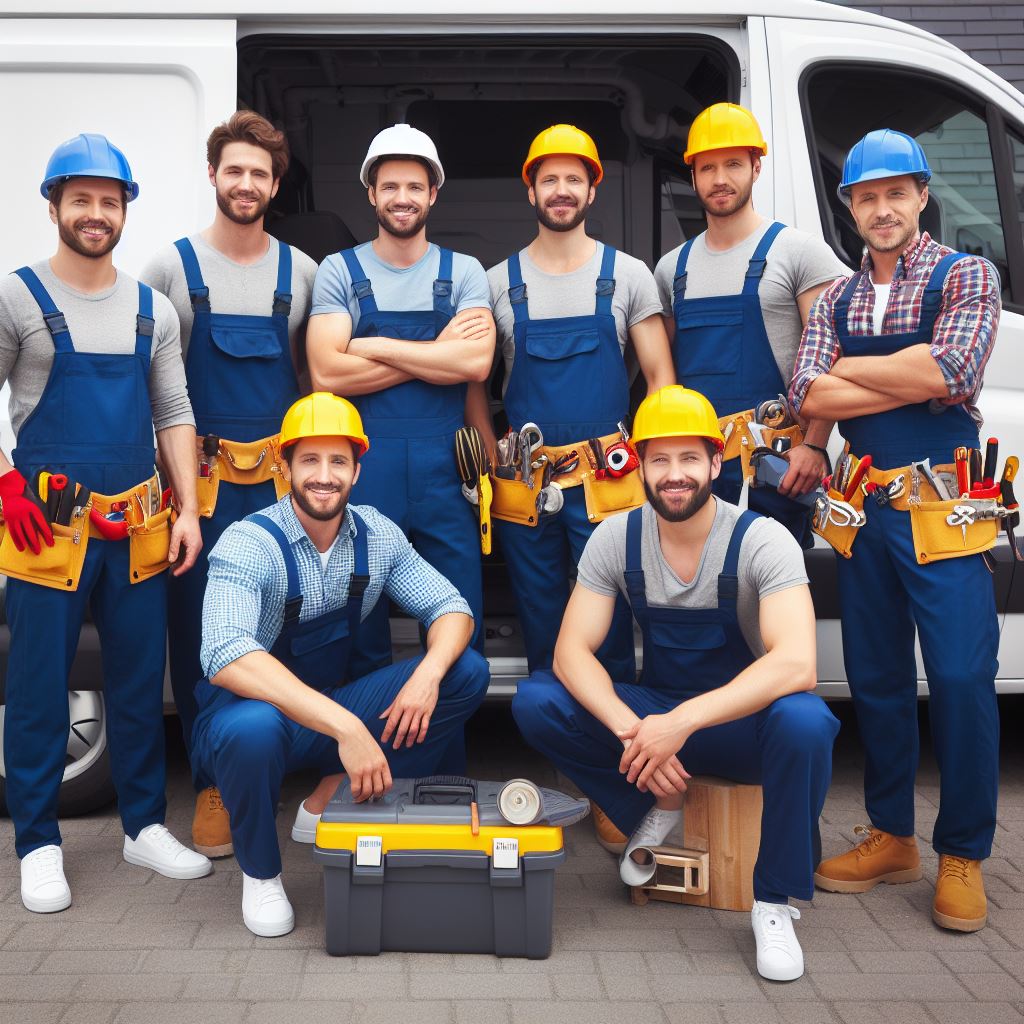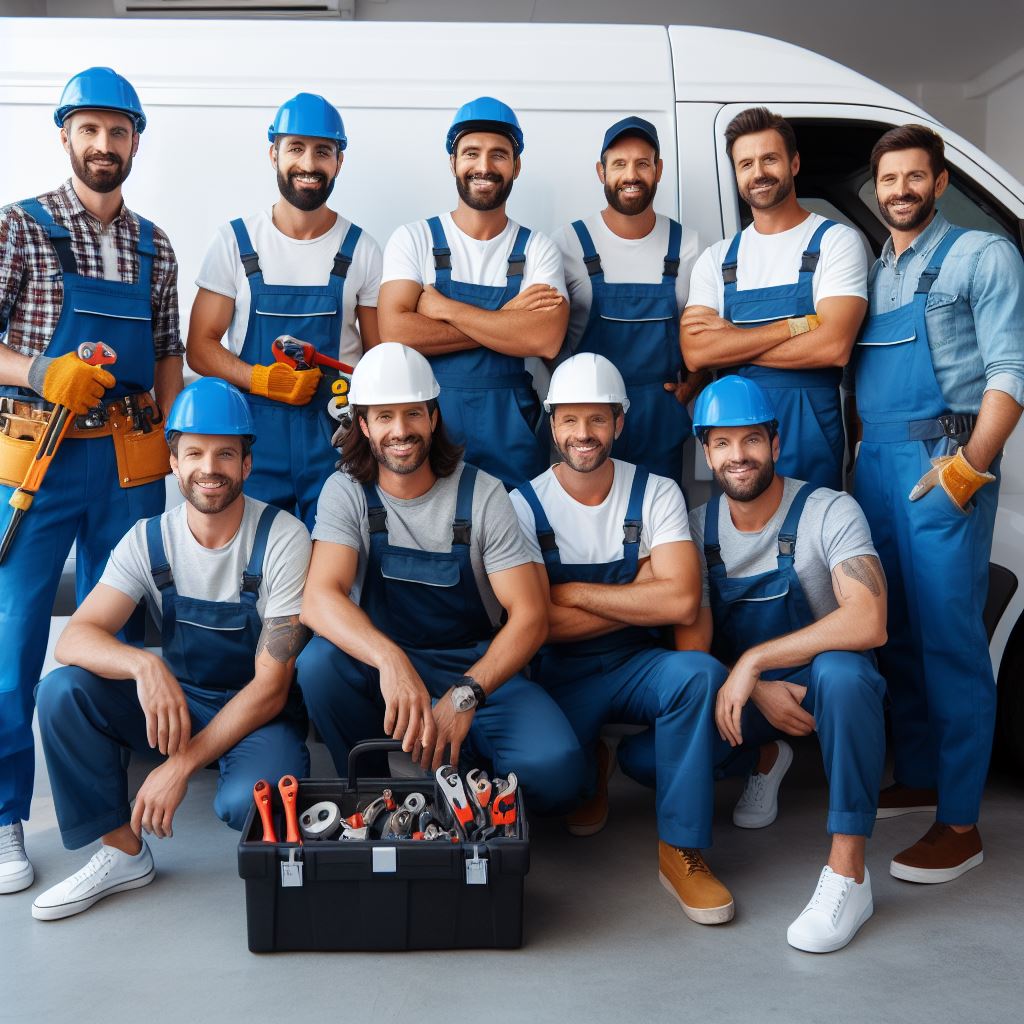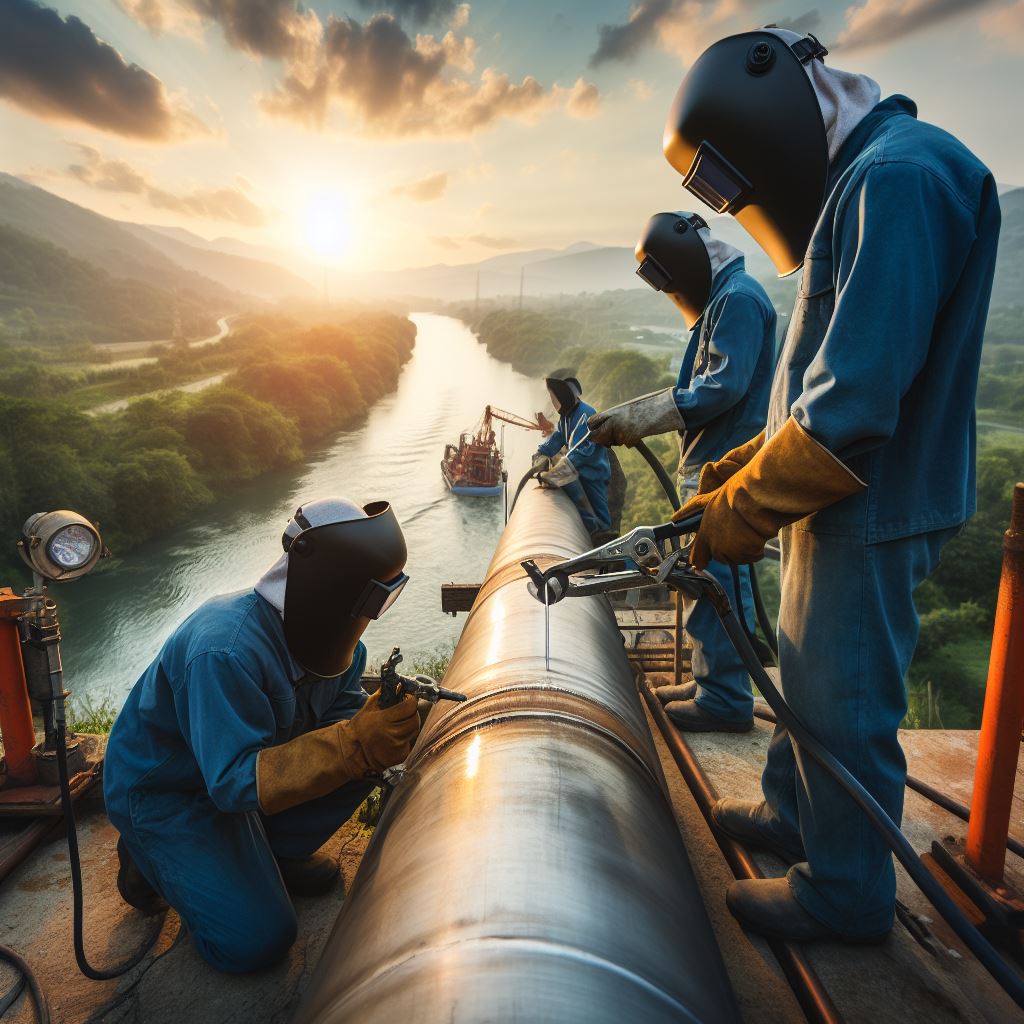Introduction
A. Importance of Infrastructure in the US
Infrastructure is the backbone of the US, encompassing roads, water systems, energy networks, and communication channels.
It forms the foundation for economic growth and societal development.
B. Thesis Statement: The Role of Plumbers in Modern Infrastructure
Plumbers hold a crucial position in maintaining, upgrading, and expanding the nation’s infrastructure.
They ensure the functionality and safety of water supply, waste disposal, and various systems critical to daily life.
In modern US infrastructure, plumbers play a pivotal role, contributing to the vitality of communities, industries, and homes.
They aid in the installation, repair, and maintenance of pipelines, ensuring clean water access and proper sanitation.
With advancements in technology and environmental concerns, plumbers also lead in implementing sustainable and efficient solutions.
Their work directly impacts public health, environmental conservation, and the overall functionality of the country’s infrastructure.
This section explores the integral role plumbers play in sustaining the contemporary infrastructure of the United States.
Overview of US Infrastructure
A. Definition and scope of US infrastructure
In the United States, infrastructure refers to the physical structures and systems that support various activities and services.
- Roads and highways
- Bridges and tunnels
- Airports and seaports
- Railway systems
- Water supply and wastewater treatment plants
- Electricity generation and transmission networks
- Telecommunication systems
These are just a few examples of the vast infrastructure network that exists in the country.
The scope of US infrastructure also includes social infrastructure such as schools, hospitals, and public transportation systems.
Overall, it encompasses all the essential physical structures and facilities that enable economic and societal activities to function efficiently.
B. Key sectors and components
The US infrastructure can be broadly categorized into several key sectors and components.
- Transportation infrastructure
- Energy infrastructure
- Water and wastewater infrastructure
- Communication infrastructure
- Public facilities and social infrastructure
The transportation infrastructure includes roads, highways, bridges, airports, railways, and other modes of transportation.
The energy infrastructure consists of power plants, electricity grids, pipelines, and other systems involved in energy generation, distribution, and storage.
The water and wastewater infrastructure involves water treatment plants, reservoirs, pipes, and sewage systems that ensure clean water supply and proper sanitation.
Communication infrastructure includes telecommunication networks, internet services, satellites, and other systems that facilitate information exchange.
Public facilities and social infrastructure encompass schools, hospitals, government buildings, public parks, and recreational centers.
All these sectors and components are vital for the functioning and development of the country.
Transform Your Career Today
Unlock a personalized career strategy that drives real results. Get tailored advice and a roadmap designed just for you.
Start NowNow that we have a brief overview of US infrastructure, let’s discuss the role of plumbers within this vast network.
Read: Historical Evolution of Plumbing in America
Importance of Infrastructure Maintenance
A. The necessity of regular maintenance
- Regular maintenance is crucial to ensure the longevity and efficiency of infrastructure.
- Preventative measures can identify and address issues before they escalate into costly repairs.
- By regularly maintaining infrastructure, potential hazards and accidents can be minimized or avoided.
- Maintenance tasks also help in preserving the structural integrity of buildings and preventing deterioration.
- Regular inspections and upkeep ensure that infrastructure is up to code and meets safety standards.
B. Impact of infrastructure breakdowns on the economy and society
- Infrastructure breakdowns can lead to disruptions in transportation, utilities, and critical services.
- These interruptions can cause significant inconvenience and economic losses for individuals and businesses.
- For example, a plumbing failure in a residential building can result in water damage and displacement of tenants.
- In the case of a major infrastructure breakdown, such as a water main burst, it can disrupt water supply to entire communities.
- The economic consequences can vary from increased repair costs to the loss of productivity and revenue for businesses.
C. The role of plumbers in infrastructure maintenance
- Plumbers play a vital role in the maintenance and upkeep of infrastructure, specifically concerning plumbing systems.
- They possess the knowledge and skills to identify, diagnose, and repair plumbing issues in a timely manner.
- Plumbers conduct routine checks to ensure the proper functioning of water supply, drainage, and sewer systems.
- They can detect leaks, blockages, and potential problems that may jeopardize the infrastructure’s integrity.
- Their expertise is essential for the longevity and efficiency of plumbing systems, minimizing the risk of breakdowns.
Regular maintenance of infrastructure is of utmost importance to ensure its functionality, safety, and economic prosperity.
Plumbing systems are a critical aspect of infrastructure maintenance, and plumbers play a crucial role in this regard.
By emphasizing the significance of regular maintenance and the impact of infrastructure breakdowns, it becomes evident that the expertise and services provided by plumbers are invaluable.
Investing in infrastructure maintenance, including plumbing systems, is not just a necessity but also a smart strategy for the sustainable development of modern US infrastructure.
Read: US Plumber Salary: A Comprehensive Breakdown by State

The Role of Plumbers in Infrastructure Development
A. The plumbing system in infrastructure
Plumbing systems in infrastructure refer to the network of pipes, fixtures, and fittings that supply clean water and remove waste.
These systems are critical in providing safe and sanitary conditions for buildings, ensuring public health and hygiene.
B. Responsibilities of plumbers in designing and installing plumbing systems
Plumbers play a crucial role in designing and installing plumbing systems in modern infrastructure.
They analyze blueprints, determine pipe sizes and layouts, and select appropriate materials for construction.
Plumbers install pipes, fixtures, and fittings, ensuring proper connections and adherence to building codes and regulations.
They test the system for leaks, perform repairs, and maintain plumbing infrastructure to maximize its lifespan.
C. Collaboration with other professionals in infrastructure projects
Plumbers work in close collaboration with architects, engineers, contractors, and other professionals involved in infrastructure projects.
They provide expertise on plumbing system requirements, ensuring compatibility with the overall building design and functionality.
Plumbers coordinate their work with electricians, HVAC technicians, and construction workers to integrate various systems seamlessly.
1. Collaborative Benefits
- Efficient design: Plumbers ensure that the plumbing system efficiently serves the needs of the building occupants.
- Effective problem-solving: Collaboration allows for effective troubleshooting and resolving any design or installation issues.
- Compliance with regulations: Professionals working together ensure compliance with plumbing codes and regulations.
- Quality assurance: Collaboration ensures a high-quality plumbing system that meets industry standards.
2. Emerging Trends
With the advancement of technology and sustainable practices, plumbers also contribute in the following ways:
- Implementation of water-saving fixtures and systems to reduce water consumption.
- Integration of smart plumbing systems that monitor and optimize water usage.
- Installation of eco-friendly solutions such as rainwater harvesting and greywater recycling systems.
- Use of sustainable materials to minimize environmental impact.
Plumbers play a vital role in the development of infrastructure, ensuring the proper functioning of plumbing systems.
Their responsibilities in designing, installing, and maintaining these systems contribute to public health, safety, and sustainable practices.
Showcase Your Business Today
Reach thousands of readers actively exploring professional services. Publish your business profile and grow your audience now.
Publish NowThrough collaboration with other professionals, plumbers optimize plumbing system efficiency and compliance with regulations.
As technologies evolve, plumbers continue to embrace innovative solutions that promote water conservation and environmental sustainability.
Read: Top Plumbing Schools and Training Centers in the US
Challenges and Innovations in Modern Plumbing
A. Overview of challenges faced by plumbers in modern infrastructure
- Increasing complexity of plumbing systems.
- Rising demand for efficient and sustainable plumbing solutions.
- Shortage of skilled plumbers in the industry.
- Dealing with aging infrastructure and outdated plumbing systems.
- Adapting to changing regulations and building codes.
In the modern US infrastructure, plumbing professionals face various challenges due to the complexity of plumbing systems and the demand for efficient, sustainable solutions.
Additionally, there is a shortage of skilled plumbers in the industry, making it crucial to explore new technologies and innovative practices.
One of the main challenges faced by plumbers today is the increasing complexity of plumbing systems.
With advancements in building designs and infrastructure, plumbing systems have become intricate, requiring specialized knowledge and skills to install and maintain.
Plumbers must possess up-to-date expertise to handle these complex systems.
Moreover, there is a growing demand for efficient and sustainable plumbing solutions to conserve resources and reduce environmental impact.
Plumbers are tasked with finding innovative ways to optimize water and energy usage, such as installing low-flow fixtures and designing efficient drainage systems.
These practices contribute to water conservation and sustainability.
However, the shortage of skilled plumbers poses a significant challenge in the industry. As older plumbers retire, there is a lack of younger, qualified individuals to replace them.
This shortage highlights the need for vocational training programs and initiatives to attract and educate the next generation of plumbers.
In addition to these challenges, plumbers also face the task of dealing with aging infrastructure and outdated plumbing systems.
Many structures in the US have plumbing systems that have surpassed their lifespan, leading to frequent repairs and maintenance.
Plumbers must adapt to these conditions, finding innovative ways to repair and upgrade outdated systems efficiently.
B. The adoption of new technologies and advancements
- Introduction of advanced plumbing tools and equipment.
- Implementation of digital technologies for precision and efficiency.
- Usage of remote monitoring and control systems.
- Integration of smart plumbing solutions for enhanced functionality.
- Adoption of eco-friendly plumbing practices to promote sustainability.
To address these challenges, the plumbing industry has embraced new technologies and advancements.
Advanced plumbing tools and equipment have made tasks more efficient and precise.
Digital technologies, such as computer-aided design (CAD) and building information modeling (BIM), assist plumbers in planning and executing projects effectively.
Remote monitoring and control systems have also been introduced to enhance plumbing maintenance and system management.
These systems enable real-time monitoring of plumbing parameters, providing plumbers with valuable data to identify issues and make informed decisions promptly.
C. Examples of innovative practices in the plumbing industry
- Utilization of trenchless pipe repair techniques to minimize disruption.
- Installation of sensor-based faucets and toilets to reduce water wastage.
- Integration of water leak detection systems for early problem identification.
- Implementation of 3D modeling and virtual reality in plumbing design.
- Adoption of sustainable materials and energy-efficient plumbing fixtures.
The integration of smart plumbing solutions has further revolutionized the industry.
Sensor-based faucets and toilets have become popular choices to minimize water wastage, promoting water conservation.
These devices detect motion or presence, automatically controlling water flow and reducing unnecessary usage.
Emerging technologies like 3D modeling and virtual reality (VR) have also found their way into plumbing design and installation.
Plumbing professionals can create virtual models of plumbing systems, visualizing potential conflicts or issues before physically implementing them.
This improves accuracy and reduces costly errors during construction.
Furthermore, the plumbing industry is actively adopting sustainable practices.
Trenchless pipe repair techniques, such as pipe relining and pipe bursting, minimize disruption and excavation compared to traditional methods.
Water leak detection systems have also been developed to identify leaks in plumbing systems at an early stage, preventing significant damage and water loss.
Lastly, the materials used in plumbing fixtures are becoming more sustainable and energy-efficient.
Plumbers are encouraged to install fixtures made from eco-friendly materials, reducing environmental impact while maintaining functionality and durability.
In a nutshell, plumbers in modern US infrastructure face various challenges, including complex systems, sustainable demands, skill shortages, and aging infrastructure.
However, through the adoption of new technologies and innovative practices, these challenges can be overcome.
By embracing advancements in tools, digital systems, and materials, plumbers can provide efficient, sustainable, and high-quality plumbing solutions.
Read: The Journey: Becoming a Licensed Plumber in the USA
Gain More Insights: Health & Fitness: Keeping Up with the Demands of Construction Work
Benefits of Effective Plumbing Systems
A. Impact of efficient plumbing on water conservation and sustainability
- Efficient plumbing systems help conserve water by reducing leaks and optimizing water usage.
- Smart technologies such as low-flow toilets and faucets can further enhance water conservation efforts.
- Sustainable plumbing practices contribute to the overall environmental sustainability of the US infrastructure.
B. Contributions to public health and safety
- Proper plumbing systems prevent the contamination of water, ensuring clean and safe drinking water.
- Well-maintained plumbing networks decrease the risks of waterborne diseases and infections.
- Efficient drainage systems prevent the buildup of stagnant water, reducing the breeding grounds for pests and diseases.
C. Cost-saving benefits of proper plumbing infrastructure
- By fixing leaks and optimizing water usage, effective plumbing systems help reduce water bills for individuals and businesses.
- Water-efficient fixtures and appliances also contribute to energy savings, reducing utility bills.
- Preventative maintenance and regular inspections of plumbing infrastructure can prevent costly repairs in the long run.
- Properly functioning plumbing systems increase property value and attract potential buyers or tenants.
Conclusion
A. Recap of the important role played by plumbers in modern US infrastructure
It is important to recognize the significant role that plumbers play in maintaining and developing the infrastructure of the United States.
From installing and repairing water and sewage systems to ensuring the proper functioning of plumbing in buildings, plumbers are essential to the functioning of modern society.
B. Final thoughts on the significance of maintaining and supporting the plumbing industry in infrastructure development and maintenance
It is crucial to acknowledge the importance of maintaining and supporting the plumbing industry in infrastructure development and maintenance.
Showcase Your Business Today
Reach thousands of readers actively exploring professional services. Publish your business profile and grow your audience now.
Publish NowWithout a strong and skilled workforce of plumbers, the infrastructure of the US would suffer, leading to potential health and safety risks for the population.
Therefore, it is vital to invest in and support the plumbing industry to ensure the continued growth and maintenance of our infrastructure.
[E-Books for Sale]
The Big Book of 500 High-Paying Jobs in America: Unlock Your Earning Potential
$19.99 • 500 High-Paying Jobs • 330 pages
Explore 500 high-paying jobs in America and learn how to boost your career, earn more, and achieve success!
See All 500 High-Paying Jobs of this E-Book
1001 Professions Without a Degree: High-Paying American Jobs You Can Start Now
$19.99 • 1001 Professions Without a Degree • 174 pages
Discover 1001 high-paying jobs without a degree! Unlock career tips, skills, and success strategies for just $19.99!




